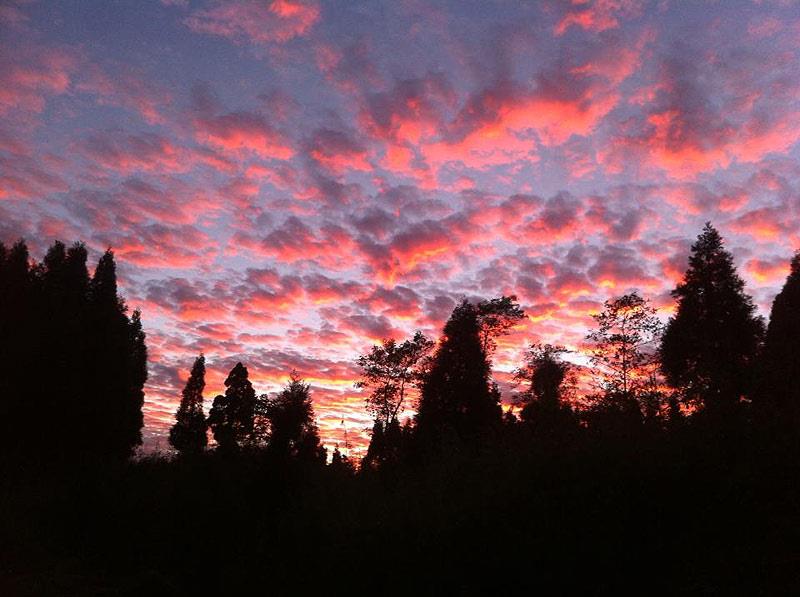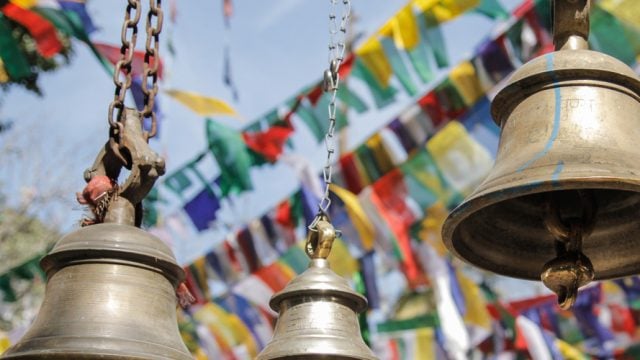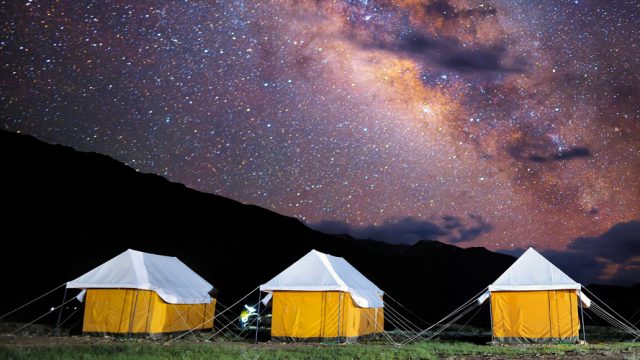Home to some of the best-loved hill stations in India, the Darjeeling hills can be visited almost
DARJEELING
Surrounded by the gardens that produce the Darjeeling tea, the ‘champagne of teas’, the eponymous town is a mix of colonial legacy and modern times. Reaching Darjeeling from the foothills, by road or the toy train (that runs on narrow gauge), is a journey by itself; mountain views, forests, waterfalls, little cottages by the wayside and tea gardens dot the Hill Cart Road. Sometimes, the toy train and the motorable road run side by side, reminding you of scenes from the movies Aradhana, Parineeta and Barfi. You can take a ride on the UNESCO Heritage-tagged Darjeeling Himalayan Railway (DHR) between Darjeeling and Ghoom.
A tourist attraction for decades, Darjeeling has a variety of options in the mid-range to budget hotels segment, besides simple homestays. We recommend the centrally located Andy’s Guest House (all basic services available, clean rooms) in the budget category. Pahari Soul, located near the Dali Monastery on Darjeeling’s outskirts, offers a great view of the mountains and free Wi-Fi. Hotel Seven Seventeen, in the mid-range category, is a boutique hotel (spacious rooms, lavish buffets and a well-stocked bar) run by a Tibetan family. Caution: Darjeeling suffers from terrible water shortage. So many budget hotels do not have running hot water supply; hot water is supplied in buckets and charged extra.
Many of Darjeeling’s attractions can be reached on foot while you need to hire a jeep to visit the far-flung ones. Take a walk around the Chowrasta or the Mall, one of the most interesting places to hang out. Weather permitting, the Mall offers a spectacular view of the Kanchenjunga snow peaks. Check out the rows of curio shops, cafés and eateries, spend some time at the Oxford Bookstore or take a pony ride. Or, you can just sit at one of the benches at the circular Mall and chat with the local people. Keventers, just off the Mall, is known for its English breakfast spread. The terrace offers a panoramic view of the snow peaks on a clear day. Just below the Planters’ Club, near the Mall, there are scores of jeeps and taxis available for hire. They cover most of the popular attractions at a fixed rate.
The Padmaja Naidu Himalayan Zoological Park,the highest zoo in India, specialises in breeding animals that are adapted to alpine conditions. The endangered Red Panda is one of the major attractions here. Make sure you see the Himalayan bear, the snow leopard and also the critically endangered Himalayan mountain wolf. Adjoining the zoo is The Himalayan Mountaineering Institute (HMI). The museum contains mountaineering paraphernalia associated with famous climbs and mountaineers, including the boots that Tenzing Norgay, the first person to reach the top of Mt Everest, was wearing when he reached the peak.
For shopping, the Mahakal Market, which is a five-minute walk downhill from Chowrasta, and Orient Road are great options. And, for the tea lover and those looking to buy the vintage tea, a visit to Nathmulls is a must; they are one of the most respected and oldest traders of Darjeeling tea; the aptly named ‘Sunset Lounge’, on the Chowrasta, is a great place to enjoy your evening ‘chai’.
Take a ride on the Rangeet Valley Passenger Cable Car or the ropeway. An engineering marvel, the ropeway was the only means of transportation from the North Point to Rangeet Valley during the British era. The present ropeway has been extensively refurbished with modern technology. Enjoy a bird’s-eye view of the valley below, the lush green tea gardens on the hill slopes, flowing rivers, forests, waterfalls and a magnificent view of the Eastern Himalayan range, including Mt Kanchenjunga.
To visit the Tiger Hill,book a cab a day in advance, so that you can start by 3.30 am. And on the way, pray hard, to whichever god you trust, for a clear sky, as the weather can be highly unpredictable. The kaleidoscopic play of colours on the snow peaks is something you will not forget in a hurry. But even on a nice and sunny day, sometimes the mist rushes in from nowhere and wraps the surroundings in a white blanket.
On the way back, you can visit the Yiga Choeling Monastery in Ghoom; it was established in 1850 by the famous Mongolian astrologer and monk, Sokpo Sherab Gyatso. The monastery belongs to the Gelukpa or the Yellow Hat sect of Buddhism. The monastery enshrines a 15-feet high statue of bodhisattva Maitreya or the Buddha of the future and contains some lovely colourful frescoes. You may sit down with the praying monks and experience the most amazing sense of calm and serenity that encompasses the area. For picking up traditional Tibetan handicraft, you can visit the Tibetan Refugee Self Help Center.
Interested in off-beat destinations? Then do visit Lamahatta, 23km away from Darjeeling. Pine trees, rivers and ponds, and terraced farmlands are the main attractions of this small mountain village. You can also make it a base for trekking in this area. Cabs can be booked for Lamahatta from the Darjeeling Motorstand.
KALIMPONG
Around 70km from Darjeeling, Kalimpong is located on a ridge connecting the two hills, Deolo and Durpin, which overlook the Teesta river. The weather remains pleasant throughout the year owing to the low altitude. Buddhist monasteries, old churches, and temples coexist in a cheerful society. Kalimpong is known for its flower and orchid nurseries. One of the most popular nurseries, the Pine View Nursery, houses over 1,500 varieties of cactii and is said to be the largest cactii nursery in Asia.
The bustling bazaar, reminiscent of the days when Kalimpong was an important trading post on the way to Tibet, oozes with old-world charm. Try to be in Kalimpong on a Saturday to enjoy the weekly Haat; people from in and around Kalimpong flock to this market for local produce, from vegetables to clothes and accessories.
Try Holumba Haven, if you are looking for a budget accommodation. A kilometre away from the main Kalimpong town, it offers cottages and tree-top rooms; it also runs a nursery with around 1,000 varieties of orchids. You may also stay at Gompu’s, located in the heart of Kalimpong. In the mid-range, you can opt for The Himalayan Hotel, a heritage property.
From the top of Deolo Hill, to the northeast of Kalimpong, you can see the Relli valley, the Teesta river and Kalimpong. Take a break at the hill-top park. At 1,704 metre, Deolo hill is also the highest point of Kalimpong town. In case you have a streak of adventure in you, this is the place to be. Paragliding and tandem flying are a few of the activities available here. Most flights are from Deolo to Relli riverside.
Zang Dhok Palri Gumba, better known as the Durpin Monastery, is located on Durpin Hill. It was consecrated by the Dalai Lama in 1976. It contains the sacred 108-volume Kangyur, which was brought by the Dalai Lama. The main prayer hall contains frescoes that seem almost three-dimensional.
For local cuisine, especially some finger-licking momos (Tibetan dumplings), pay a visit to Gompu’s or just enjoy the street food sold in front of Kanchen. You may try the Phambi and Lefing at Acha’s. King Thaiis a popular watering hole. To taste some home-made Kalimpong-style Chinese food, visit Lee’s.
Lava, a small hamlet located near Kalimpong, is the entry point to the Neora National Park. The place is popular with trekkers and bird watchers. You can also visit Lolaygaon and Rishop.
KURSEONG
The land of white orchids, Kurseong is a sleepy little town, on the way to Darjeeling. The serenity and splendour of Kurseong had attracted famous personalities such as Rabindranath Tagore and Netaji Subhash Chandra Bose to spend some time here. Mark Twain is also supposed to have visited this place in 1885. But today, lying in the shadow of big brother Darjeeling, it is mostly ignored by tourists. At a height of 4864ft, Kurseong is perfect for those who want to enjoy the alpine surrounding without worrying about the bone-chilling cold weather. Kurseong has some very old residential schools.
The Kurseong Tourist Lodge is the best option for a budget accommodation. Just a walk away from the bazaar, it offers a great view of the valley below. Hotel Amarjeet, near the main market, is another budget option with clean rooms.
Even if you are not staying at The Cochrane Place, do visit its tea bar Chai Country; the restaurant serves some special tea-based dishes – the tea-based chicken recipe is a favourite with visitors. Zimba’s, at the Kurseong Bus Stand, is a local favourite.
The Eagle’s Craig view point is located near Kurseong. Perched on a cliff, it has a cafeteria, a watch tower and a flower garden; the reservoir here supplies water to Kurseong. From here, you will get a marvellous view of the plains of Siliguri, especially at night, with the horizon dotted with bright lights.
The forested slopes of Dow Hill have a Deer Park (managed by the state forest department)and the forest museum. At the museum, you can get an idea about the local flora and fauna. The grotto houses a beautiful statue of Virgin Mary and is located in the middle of a forested patch.
Visit the Tamang Gompa in Kurseong during the evening to witness the evening prayers. Wisps of incense smoke along with the fervent chanting of mantras by monks in their deep-throated voice will transport you to someplace else.
The world’s first tea factory, Makaibari Tea Estate, was established in 1859. You can visit the factory, preferably in the morning, to see for yourself how the Darjeeling tea leaves are processed.
The information
Getting there
Nearest airport: Bagdogra – 94 km from Darjeeling, 76 km from Kalimpong and 40 km from Kurseong
Nearest road and rail head: New Jalpaiguri (NJP) and Siliguri.
Plenty of shared as well as private cab services are available from all these places to Darjeeling, Kalimpong and Kurseong.
DARJEELING
Where to stay
Andy’s Guesthouse, 102, Zakir Hussain Road, Darjeeling; Tel: 0354-2253125; Tariff: Rs 1,000 onwards
Hotel Seven Seventeen, H.D.Lama Road, Darjeeling; Tel: 0354- 225509/2252017/2254717, www.hotel717.com; Tariff: Rs 2,200 onwards
Pahari Soul, 46 Hill Cart Road, Dali Darjeeling; Tel: 0354-2272024, 9800214163, 9800215284
www.paharisoul.com; Tariff: Rs 1,500 onwards
Where to eat
Glenary’s, Keventers, The Park, Blind Date – Himalayan Food, Boney’s Snack Bar, Kunga Restaurant
Where to go
Japanese Temple, Happy Valley Tea Estate, The Mahakal Temple, The Rock Garden, etc are some of the other places you could visit.
KALIMPONG
Where to stay*
Holumba Haven, P.O Box-50, Kalimpong, 734301; Tel: 03552- 255435, www.holumba.com; Tariff: Rs 1,400 onwards
Himalayan Hotel, Upper Cart road, Kalimpong; Tel: 03552- 255248/ 258602, [email protected]; Tariff: Rs 2,100 onwards
Gompu’s Hotel, Damber Chowk, Kalimpong; Tel: 03552- 255818/ 09932054528/ 09126000818/ 09832435448; Tariff: Rs 1,600 onwards
Where to eat
King Thai, Gompus, Acha’s, 3C’s, Lee’s, Fresh Bite
Where to go
Relli riverside, Durpin Dara, Loleygaon, Kafir
KURSEONG
Where to stay*
Kurseong Tourist Lodge, Hill Cart Rd, Kurseong, 734283; Tel: 0354- 2344409/2345608; Tariff: Rs 1,200 onwards
Hotel Amarjeet, 12 T.N Road, Kurseong; Tel: 0354-2344678 / 2344519/09800869678, www.theamarjeethotel.com; Tariff: Rs 2,000 onwards
Where to eat
Cochrane Place, Zimba’s, Batloi, Hotel Amarjeet
Where to go
Ani Gumba, Castleton Tea Estate, Makaibari Tea Estate, Bhangzang Salamander Lake
*Note: Hotel tariffs provided are for off-peak season and are subject to change. Please contact the hotels for latest rates.
Kalimpong
Kurseong
West Bengal
Leave a Reply
You must be logged in to post a comment.





